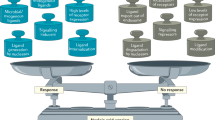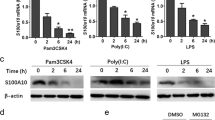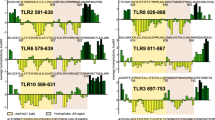Abstract
Members of the Toll family of single-pass transmembrane receptors are key mediators of innate immunity in both vertebrates and invertebrates. They respond to various pathogen-associated stimuli and transduce the complex signalling responses that are required for inflammation and for the subsequent development of adaptive immunity. Here, we propose a molecular mechanism for signalling by the Toll and Toll-like receptors that involves a series of protein conformational changes initiated by dimerization of their extracellular domains. The initial dimerization event, which is triggered by the interaction of the receptor with its ligand, might disrupt a pre-formed but non-functional dimer. Formation of a stable receptor–ligand complex then relieves constitutive autoinhibition, enabling receptor–receptor association of the extracellular juxtamembrane regions and cytoplasmic signalling domains. This activation process constitutes a tightly regulated, unidirectional molecular switch.
This is a preview of subscription content, access via your institution
Access options
Subscribe to this journal
Receive 12 print issues and online access
$209.00 per year
only $17.42 per issue
Buy this article
- Purchase on Springer Link
- Instant access to full article PDF
Prices may be subject to local taxes which are calculated during checkout





Similar content being viewed by others
References
Belvin, M. P. & Anderson, K. V. A conserved signaling pathway: the Drosophila Toll–Dorsal pathway. Annu. Rev. Cell Dev. Biol. 12, 393–416 (1996).
Akira, S. & Takeda, K. Toll-like receptor signalling. Nature Rev. Immunol. 4, 499–511 (2004).
Iwasaki, A. & Medzhitov, R. Toll-like receptor control of the adaptive immune responses. Nature Immunol. 5, 987–995 (2004).
Beutler, B. & Poltorak, A. Sepsis and evolution of the innate immune response. Crit. Care Med. 29, S2–S6; discussion S6–S7 (2001).
Rock, F. L., Hardiman, G., Timans, J. C., Kastelein, R. A. & Bazan, J. F. A family of human receptors structurally related to Drosophila Toll. Proc. Natl Acad. Sci. USA 95, 588–593 (1998).
Buchanan, S. G. S. & Gay, N. J. Structural and functional diversity in the leucine rich repeat family of proteins. Prog. Biophys. Mol. Biol. 65, 1–44 (1996).
Fan, Q. R. & Hendrickson, W. A. Structure of human follicle-stimulating hormone in complex with its receptor. Nature 433, 269–277 (2005).
Schimmele, B. & Pluckthun, A. Identification of a functional epitope of the Nogo receptor by a combinatorial approach using ribosome display. J. Mol. Biol. 352, 229–241 (2005).
Alder, M. N. et al. Diversity and function of adaptive immune receptors in a jawless vertebrate. Science 310, 1970–1973 (2005).
Weber, A. et al. Binding of the Drosophila cytokine Spätzle to Toll is direct and establishes signaling. Nature Immunol. 4, 794–800 (2003).
Nagai, Y. et al. Essential role of MD-2 in LPS responsiveness and TLR4 distribution. Nature Immunol. 3, 667–672 (2002).
Inohara, N. & Nunez, G. ML – a conserved domain involved in innate immunity and lipid metabolism. Trends Biochem. Sci. 27, 219–221 (2002).
Gangloff, M. & Gay, N. J. MD-2: the Toll 'gatekeeper' in endotoxin signalling. Trends Biochem. Sci. 29, 294–300 (2004).
Hailman, E. et al. Lipopolysaccharide (LPS)-binding protein accelerates the binding of LPS to CD14. J. Exp. Med. 179, 269–277 (1994).
Weber, A. N., Moncrieffe, M. C., Gangloff, M., Imler, J. L. & Gay, N. J. Ligand–receptor and receptor–receptor interactions act in concert to activate signaling in the Drosophila Toll pathway. J. Biol. Chem. 280, 22793–22799 (2005).
Winans, K. A. & Hashimoto, C. Ventralization of the Drosophila embryo by deletion of extracellular leucine-rich repeats in the Toll protein. Mol. Biol. Cell 6, 587–596 (1995).
Medzhitov, R., Preston-Hurlburt, P. & Janeway, C. A. Jr . A human homologue of the Drosophila Toll protein signals activation of adaptive immunity. Nature 388, 394–397 (1997).
Schneider, D. S., Hudson, K. L., Lin, T. Y. & Anderson, K. V. Dominant and recessive mutations define functional domains of Toll, a transmembrane protein required for dorsal ventral polarity in the Drosophila embryo. Genes Dev. 5, 797–807 (1991).
Hu, X., Yagi, Y., Tanji, T., Zhou, S. & Ip, Y. T. Multimerization and interaction of Toll and Spätzle in Drosophila. Proc. Natl Acad. Sci. USA 101, 9369–9374 (2004).
Shimazu, R. et al. MD-2, a molecule that confers lipopolysaccharide responsiveness on Toll-like receptor 4. J. Exp. Med. 189, 1777–1782 (1999).
Matsumoto, M., Kikkawa, S., Kohase, M., Miyake, K. & Seya, T. Establishment of a monoclonal antibody against human Toll-like receptor 3 that blocks double-stranded RNA-mediated signaling. Biochem. Biophys. Res. Commun. 293, 1364–1369 (2002).
Koshland, D. E. Jr . The structural basis of negative cooperativity: receptors and enzymes. Curr. Opin. Struct. Biol. 6, 757–761 (1996).
Urizar, E. et al. Glycoprotein hormone receptors: link between receptor homodimerization and negative cooperativity. EMBO J. 24, 1954–1964 (2005).
He, X. L. & Garcia, K. C. Structure of nerve growth factor complexed with the shared neurotrophin receptor p75. Science 304, 870–875 (2004).
Bell, J. K. et al. The molecular structure of the Toll-like receptor 3 ligand-binding domain. Proc. Natl Acad. Sci. USA 102, 10976–10980 (2005).
Choe, J., Kelker, M. S. & Wilson, I. A. Crystal structure of human Toll-like receptor 3 (TLR3) ectodomain. Science 309, 581–585 (2005).
Kirk, P. & Bazan, J. F. Pathogen recognition: TLRs throw us a curve. Immunity 23, 347–350 (2005).
Bell, J. K., Askins, J., Hall, P. R., Davies, D. R. & Segal, D. M. The dsRNA binding site of human Toll-like receptor 3. Proc. Natl Acad. Sci. USA 103, 8792–8797 (2006).
O'Neill, L. A. J., Fitzgerald, K. A. & Bowie, A. G. The Toll–IL-1 receptor adaptor family grows to five members. Trends Immunol. 24, 286–290 (2003).
Xu, Y. W. et al. Structural basis for signal transduction by the Toll/interleukin-1 receptor domains. Nature 408, 111–115 (2000).
Dunne, A., Ejdeback, M., Ludidi, P., O'Neill, L. A. J. & Gay, N. J. Structural complementarity of Toll/interleukin-1 receptor identity regions in Toll-like receptors and the adaptors Mal and MyD88. J. Biol. Chem. 278, 41443–41451 (2003).
Fitzgerald, K. A. et al. LPS–TLR4 signaling to IRF-3/7 and NF-κB involves the Toll adapters TRAM and TRIF. J. Exp. Med. 198, 1043–1055 (2003).
Lu, X., Gross, A. W. & Lodish, H. F. Active conformation of the erythropoietin receptor: random and cysteine-scanning mutagenesis of the extracellular juxtamembrane and transmembrane domains. J. Biol. Chem. 281, 7002–7011 (2006).
Poltorak, A. et al. Defective LPS signaling in C3H/HeJ and C57BL/10ScCr mice: mutations in Tlr4 gene. Science 282, 2085–2088 (1998).
Tao, X., Xu, Y. W., Zheng, Y., Beg, A. A. & Tong, L. An extensively associated dimer in the structure of the C713S mutant of the TIR domain of human TLR2. Biochem. Biophys. Res. Commun. 299, 216–221 (2002).
Ronni, T. et al. Common interaction surfaces of the Toll-like receptor 4 cytoplasmic domain stimulate multiple nuclear targets. Mol. Cell. Biol. 23, 2543–2555 (2003).
Gioannini, T. L. et al. Isolation of an endotoxin–MD-2 complex that produces Toll-like receptor 4-dependent cell activation at picomolar concentrations. Proc. Natl Acad. Sci. USA 101, 4186–4191 (2004).
Alexopoulou, L., Holt, A. C., Medzhitov, R. & Flavell, R. A. Recognition of double-stranded RNA and activation of NF-κB by Toll-like receptor 3. Nature 413, 732–738 (2001).
Bauer, S. et al. Human TLR9 confers responsiveness to bacterial DNA via species-specific CpG motif recognition. Proc. Natl Acad. Sci. USA 98, 9237–9242 (2001).
Diebold, S. S., Kaisho, T., Hemmi, H., Akira, S. & Reis e Sousa, C. Innate antiviral responses by means of TLR7-mediated recognition of single-stranded RNA. Science 303, 1529–1531 (2004).
Hemmi, H. et al. Small anti-viral compounds activate immune cells via the TLR7 MyD88-dependent signaling pathway. Nature Immunol. 3, 196–200 (2002).
Bell, J. K. et al. Leucine-rich repeats and pathogen recognition in Toll-like receptors. Trends Immunol. 24, 528–533 (2003).
Gibbard, R. J., Morley, P. J. & Gay, N. J. Conserved features in the extracellular domain of human Toll-like receptor 8 are essential for pH dependent signalling. J. Biol. Chem. 20 July 2006 (doi:10.1074/jbc.M605003200).
Latz, E. et al. TLR9 signals after translocating from the ER to CpG DNA in the lysosome. Nature Immunol. 5, 190–198 (2004).
Lee, J. et al. Molecular basis for the immunostimulatory activity of guanine nucleoside analogs: activation of Toll-like receptor 7. Proc. Natl Acad. Sci. USA 100, 6646–6651 (2003).
Barton, G. M., Kagan, J. C. & Medzhitov, R. Intracellular localization of Toll-like receptor 9 prevents recognition of self DNA but facilitates access to viral DNA. Nature Immunol. 7, 49–56 (2006).
Husebye, H. et al. Endocytic pathways regulate Toll-like receptor 4 signaling and link innate and adaptive immunity. EMBO J. 25, 683–692 (2006).
Schlessinger, J. Ligand-induced, receptor-mediated dimerization and activation of EGF receptor. Cell 110, 669–672 (2002).
Cho, H. S. et al. Structure of the extracellular region of HER2 alone and in complex with the Herceptin Fab. Nature 421, 756–760 (2003).
Klosterman, P. S., Shah, S. A. & Steitz, T. A. Crystal structures of two plasmid copy control related RNA duplexes: an 18 base pair duplex at 1.20 Å resolution and a 19 base pair duplex at 1.55 Å resolution. Biochemistry 38, 14784–14792 (1999).
Mizuguchi, K., Parker, J. S., Blundell, T. L. & Gay, N. J. Getting knotted: a model for the structure and activation of Spätzle. Trends Biochem. Sci. 23, 239–242 (1998).
Acknowledgements
The authors thank the Medical Research Council (UK), the Biotechnology and Biological Sciences Research Council (UK) and the Wellcome Trust (UK) for grant support.
Author information
Authors and Affiliations
Corresponding author
Ethics declarations
Competing interests
The authors declare no competing financial interests.
Related links
Rights and permissions
About this article
Cite this article
Gay, N., Gangloff, M. & Weber, A. Toll-like receptors as molecular switches. Nat Rev Immunol 6, 693–698 (2006). https://doi.org/10.1038/nri1916
Published:
Issue Date:
DOI: https://doi.org/10.1038/nri1916
This article is cited by
-
Repeated Use of Morphine Induces Anxiety by Affecting a Proinflammatory Cytokine Signaling Pathway in the Prefrontal Cortex in Rats
Molecular Neurobiology (2023)
-
Structure and dynamics of Toll immunoreceptor activation in the mosquito Aedes aegypti
Nature Communications (2022)
-
Role of Microgliosis and NLRP3 Inflammasome in Parkinson’s Disease Pathogenesis and Therapy
Cellular and Molecular Neurobiology (2022)
-
TLR3 agonists: RGC100, ARNAX, and poly-IC: a comparative review
Immunologic Research (2021)
-
Fever Induced by Zymosan A and Polyinosinic-Polycytidylic Acid in Female Rats: Influence of Sex Hormones and the Participation of Endothelin-1
Inflammation (2021)



